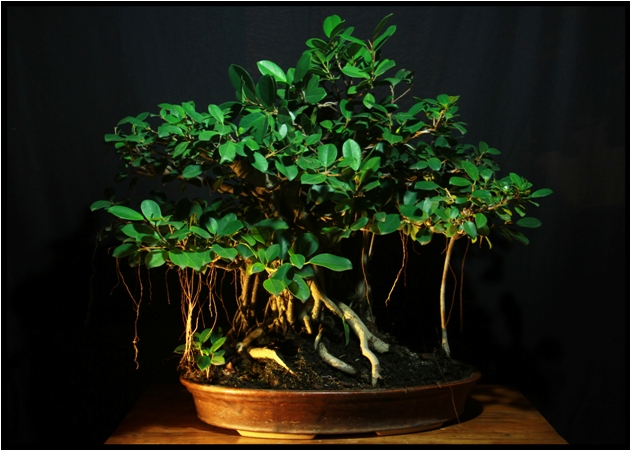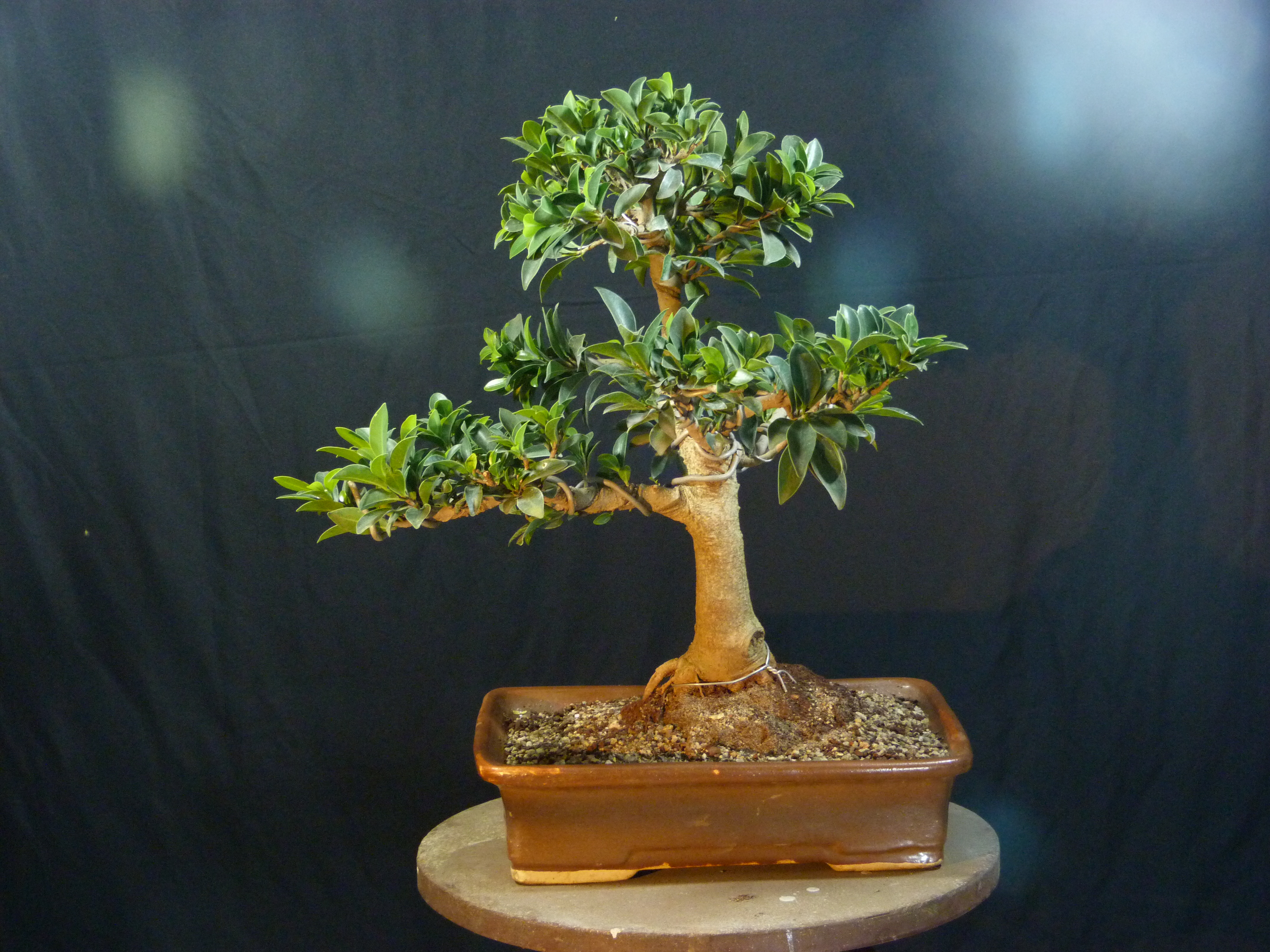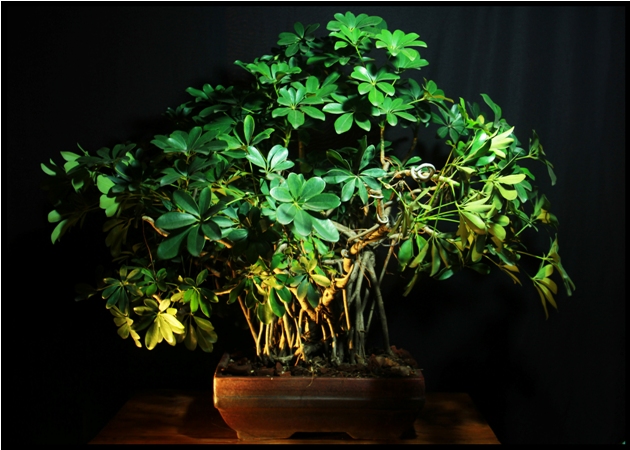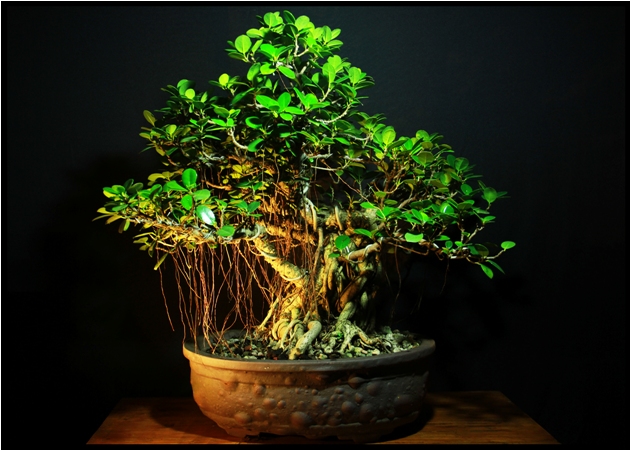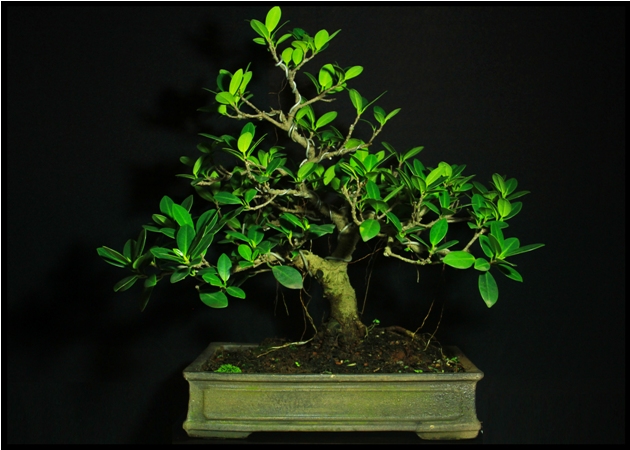PERCEPTIONS and PERSPECTIVES in BONSAI DESIGN
(part of my article entitled: The Living Art of Bonsai)
By definition a bonsai is a miniature tree planted in a tray or dish, evoking the majesty and beauty of a venerable old tree in nature with all its attributes such as tapering trunk, all round branch spread and a ground – gripping root flare. The whole concept of designing a bonsai revolves around the central idea of developing a plant into a tree which will display all the above attributes albeit on a miniature scale.
But all trees in nature are not impressive enough; many of them are young & immature and not so shapely. Trees which merit the adjectives old, majestic or beautiful are seen to have a bole which emerges from a root flare which appears to grip the soil firmly giving the first inkling of old age; there is a gradual transition from the powerfully impressive bole to a trunk breaking out into spreading branches which become smaller and thinner as the trunk tapers gradually to an apex of small branchlets. The tree appears balanced and graceful in its given setting. That is the aim in creating a bonsai-a balanced, graceful yet mature tree on a miniature scale, created through art, horticultural science and patience.
At the core of the art of bonsai therefore, are two interdependent factors: the perception of a potential tree form in the raw material and the conversion of this raw material into a recognizable tree form by means of horticultural skills.
INSPIRATIONS FROM NATURE
Since the design of bonsai depends on the designs of natural trees it is necessary, in order to design a bonsai, to know what key factors influence the shape and design of trees in nature. All trees have genetic characteristics peculiar to their species and are recognized by the distinctions in the following physiological factors:
Trunk Definition: The shape, inclination and movement of the trunk defines and distinguishes the style which is basically a classification of the different genetic tree forms seen in nature – thus a tree with a straight trunk is stated as having a Formal Upright style, a curved trunk denotes the Informal Upright style, a tree with a downward slanting trunk is called a Semi-cascade style, a trunk plunging way down indicates a Cascade style, a tree with a slanting trunk has a Slanting style, no fixed trunk direction for a Bunjin style, a tree with a trunk amp; branches sweeping in one direction is known as having the Windswept style and a straight trunk with branches emerging from one point is called the Broom style – all these styles have a trunk line with specific shapes and movement which gives the tree its special character.
Branch Silhouette and Root Flare: The silhouette of the tree also depends on the spread and arrangement of the branches and their periphery denotes a specific outline. Formal Upright, Informal Upright, Slanting, Cascade / Semi-cascade and the Windswept style will have an alternate left-right branch arrangement and a triangular outline whereas the Windswept and Broom styles will have a more rounded silhouette. A tree with a straight trunk (Formal Upright style) will have straighter branches with an alternate left-right arrangement although they may be slanted at a downward angle and its roots will disappear into the soil sloping down conspicuously on both the right and left sides. The silhouette will therefore be triangular and flow along the left-right axis. A tree with a curved trunk (Informal Upright style) is more convincing if the branches are also curved and sweeping and the roots are slightly up-curved before they disappear into the soil. Again, the branch arrangement is seen along the left-right axis and the roots too are conspicuous on both the right and left sides. If the trunk of a tree is slanting (Slanting style) the branches should appear to reach out away from the tree as if they are doing a balancing act and the roots should also reach out to the side opposite the lean. The trunk & branches in the Windswept tree design follow the wind direction although occasionally the trunk may lean into the wind. The silhouette is therefore almost triangular but somewhat softer, its outline defined by the extreme unidirectional sweep of even the branches growing from the opposite side. The roots grow more prominently in the direction opposite its lean as the tree counters the wind pull by growing stronger roots in that direction. The Broom style will have branches growing in all directions and a root flare to match. In other words, in any style, a critical design balance is achieved because the trunk direction & movement, the arrangement and sweep & sway of the branches and the positioning of the roots are in perfect co-relation with each other. It is this co-relation and the perspective between the three physiological factors which differentiates the impressive trees from the ordinary ones.
On the other hand, a lack of unity between these three physiological aspects will not make for a convincing & impressive tree image but will look more like a quirk of nature. For example, when the tree has a wavy, swaying trunk which projects femininity, then straight perpendicular branches emerging at almost right angles to this trunk and stiff & straight surface roots will look utterly out of place; a straight trunk which projects a masculine image will look incongruous if it is coupled with wavy, undulating branches and wavy amp; thin or puny surface roots. Similarly, a tree in a parkland setting which does not have to compete with other trees will look incongruous unless it is complimented by a virtually symmetrical spread of branches and a strong surface root flare radiating in all directions. A tree with branches sweeping to one side will look odd if it does not lean into or away from the wind direction and the surface roots do not grow strongly in the direction opposite its lean. A tree with peeled bark and branches will rarely show lush, luxuriant foliage; its foliage will normally show the ravages of the forces in their shorter branching & sparse foliage and its roots will be visibly strong enough to withstand the strong natural forces. In other words, exceptions to lack of unity in these physiological aspects are a rarity than a regular feature in nature.
The shapes of trees in nature are defined genetically but their designs are influenced by their environment and by natural forces. Thus a tree standing alone in a parkland setting and in a moderate climate will have a staid form irrespective of its genetic shape; a tree which has to compete with other nearby trees for sunlight and water may have a curving trunk or a dwarfed stature; grouped trees have to grow in a naturally upright habit as the crowding of trunks does not allow trunk deviation except for trees standing on the periphery of the group which are inclined to swing outwards & away from the main body of the group. A tree under the constant pressure of strong winds or stormy weather will show the effects of these natural forces in its dynamic design with a swirling trunk and wind-lashed branches or in the peeled & stripped bark and gnarled trunk showing a lot of deadwood. So, genetics dictate the trunk configuration but the environment influences their design distinctions.
The human brain has unlimited capacity to store impressions of things which we see, hear or feel. Dynamics such as culture, learning, information, other aesthetic qualities & values, experience, as also religion and philosophy, etc., influence our perceptions of things allowing the human brain to perceive and interpret things accordingly. Trees with impressive physiological features i.e., trunk movement, placement of branches & their silhouette and exposed root flare seen in nature portray the universal precepts of majesty, beauty and gracefulness and such exquisite characteristics positively impress the sub-conscious and the impressions formed thereby are indelibly incised in the human memory and stored for future reference. When the dynamics of perception and imagination are applied to these images from memory, the physiological aspects are enhanced and impressive real-life images are employed by human endeavor to create idealistic versions of the natural tree images. In other words, the beauty and majesty in the tree forms seen in nature inspire the concepts of bonsai design and these are replicated by the bonsai artist by simulating the natural factors and settings using known and sometimes inventive horticultural skills and imagination.
QUEST FOR PERFECTION
Every tree, be it from a tropical or temperate climate is basically molded by its species and the special characteristics of its family. Bonsai are no exception to this generality. Strictly speaking though, bonsai are not blind copies of natural trees; rather, they are the distillation of the best and most beautiful attributes of the trees we see in nature. The artist employs his artistic ability and horticultural skills to exploit the perceived potential in the plant material to create a bonsai of his vision with all the physiological aspects in a scaled down perspective. It is the artists’ memory and skill which serve as tools in creating the ideal form in the bonsai in a given setting.
Given the physiological factors, the setting and the artistic ability of the artist, every bonsai has a story to tell; its style and setting will depict a history of either staid good fortune (reflected in its all-round and even growth) or of competition with other trees (reflected in frequent deviations in the trunk and/or unequal branches) or of harsh or stormy weather and turbulent times (reflected in windswept and/or whipped trunk and branches or peeled bark on trunk & branches and sparse foliage). But this will happen only when the bonsai, its container and setting move as a unit.
However, there are several factors which may go wrong in the planning of the bonsai design and bring about imperfections and inadequacies in the design of a bonsai:
Many a times a bonsai although it is designed conventionally with perfect branch arrangement etc., may not look perfect and the composition may lack beauty; a bonsai may sometimes fail to evoke any special feeling when we look at it. This may be because of a number of reasons: the bonsai may lack a focal point, its visual mass or silhouette and /or the trunk line direction & movement may be contradicting each other or its position in and articulation with the container might not feel correct. Sometimes the bonsai may outgrow its original design and grow in a way not envisaged by the artist, because, after all, it is actually Nature which grows the tree. Many a times a bonsai as a tree individually may be good to look at but the overall composition may still feel wrong if any one of the physiological aspects mentioned above is at variance with the style, taken together with its container and its setting therein.
Whenever a bonsai fails to make the visual impact it would make if all the aspects were in accord, its impression as a replica of a tree in nature is lost and it will appear to be less beautiful and less than perfect; a re-thinking of the design becomes necessary therefore, if the bonsai is to look beautiful & impressive and reach its full potential as a tree evokative of grandeur, majesty and to a degree, refined mysticism.
The following are suggested as possible design considerations for creating a perfect & beautiful bonsai. Of course, these are subjective and just suggestive, but they will help initiate re-thinking for a more suitable and possibly a better design of the bonsai. All factors and each individual case, however, should be considered in their overall perspective:
a) Creation of a focal point which catches the eye of the viewer; The focal point holds the attention and displays to advantage the strong points in the physiognomy of the bonsai. It may be anything: pecularities in the trunk, specific branch placement and ramification or in the case of conifers, the deadwood features. If a focal point already exists, it may need to be enhanced or displayed to its best advantage and full potential. The bonsai will appear impressive visually when its strong points are raised from obscurity and highlighted to their full potential.
b) The visual weight of branches and foliage mass which gives the bonsai its periphery & silhouette has to be adjusted suitably. For example, if the bonsai has a stormy setting, its visual mass cannot appear to be evenly distributed; some branches are bound to be shorter and some more volatile & explosive than others. If it is placed on a rock, its roots are bound to either hug the counters of the rock or flow down the slope of the rock and its branches are more likely to articulate with the counters of the rock as if they are affected and shaped by the lift of the wind, a factor which is of relevance in all mountainous landscapes. The visual weight of the foliage should be greater than the pot size but not so great that the bonsai will look like it will topple over any moment; at the same time the counters of the foliage should complement the trunk movement, size and placement.
The overall volume and structure of the foliage mass also depends on the type of the plant material, i.e., whether it is a conifer or a semi-deciduous / broadleaf evergreen. Further, coniferous varieties, especially those which are amenable to deadwood carving will look better with just the right amount of deadwood and just the right amount of foliage. Sometimes the deadwood can be overwhelming, overpowering and purposeless, looking as if it has been carved merely because the artist wishes to show deadwood; it gives a confused look to the bonsai. Deadwood features need to be arranged and carved suitably so that the bonsai portrays the image of a tree which has faced harsh climatic conditions & trying times. The volume of foliage and its structure also needs to be finely tuned and arranged suitably by careful wiring wherever necessary, to portray the particular image conjured by the deadwood.
In the case of semi-deciduous / broadleaf evergreen trees, which incidentally also sport powerful & heavy trunk/s, abundance of foliage will speak of a lush, rich and sometimes tropical climate and therefore such trees should be having ample masses of foliage and branches to portray that climate and the ramification would need to be heavy enough to justify the powerfully growing trunk and abundance of branches.
c) Many bonsai are seen to have the entire foliage in a single contiguous mass or with markedly defined branches bare of foliage for a short distance from the junctions but with foliage at their ends clipped in the shape of pom-poms. Such bonsai look artificial and unnatural. The foliage masses of trees in nature, when seen from afar may look contiguous, but viewed up close the gaps and de-structured nature of the foliage counters can be seen clearly. The bonsai, since they emulate natural trees and since they are viewed from near, should also have a de-structured look of naturally growing branches and foliage and although they are pruned whenever necessary to keep the overgrowth in control, they should not have bunched up pom-pom like foliage. Artificiality can thus be avoided.
d) A bonsai design is primarily a composition of the tree and its container. Both the tree and the container need to compliment and co-relate to each other in the first place. The placement and the angle of articulation also are important and therefore particular attention needs to be paid to them when designing/redesigning a bonsai. The container also plays an important part in the aesthetics of bonsai design. A visually heavier or bigger pot in comparison to the foliage mass has the negative effect of making even perfectly beautiful trees appear insignificant. The largest dimension of the pot whether its length or height, when they are visually smaller than the branch spread will display & highlight the dimensions of the tree. In most cases, a flatter pot is visually more appropriate than a deeper pot simply because it has a horizontal surface representing earth and again because it’s visual weight is reduced to the thickness or height of the pot and would automatically appear visually smaller than the bonsai. The suitability of the geometric shape of the pot in relation to the style of the tree also needs to be considered carefully. The placement of the tree too should have a say in the bonsai design. The centrally off-center placement of the tree enhances the stability and balance of the tree. The positioning of the tree & the angle of the trunk as it emerges from the pot has a specific articulation with the horizontal surface of the soil and has a vital role to play in defining the style of the bonsai and in the overall visual impression of the bonsai.
The artist’s efforts are to be necessarily directed to using his skills and his imagination to simulate the impression of a venerable old tree irrespective of its actual age. It is the skill of the bonsai artist which, through the application of refined horticultural skills and imagination puts all the relevant factors of the bonsai design in their proper perspective and reveals in time the innermost beauty of the bonsai and breathes the spirit of a natural tree into it. But the skill and imagination of the artist are a variable factor, differing from person to person and one environmental setting to the other. The bonsai artist therefore needs to constantly seek ways to improve and hone his skills and upgrade his knowledge to be able to impart the natural grace, balance and feel to bonsai which makes them beautiful and perfect.
To sum up, there should be an agreement between the following three vital physiological factors: – 1) trunk definition; 2) branch silhouette; and 3) root flare. The shape of the trunk which determines the style, the branching pattern which describes the silhouette of the tree and rootage flare indicating the transition of the roots into the trunk – all these have a role to play.
The words of Master John Naka, doyen of bonsai, saying “Do not make your tree look like a bonsai, make your bonsai look like a tree” are pertinent in this respect and in a nutshell, they reflect the quintessence and philosophy of bonsai design.

